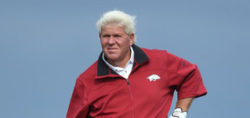How One Tour Pro Is Utilizing Data To ‘Weaponize’ His Game

Good piece by Guy Yocom on GolfDigest.com on how Zach Johnson is embracing performance analytics to further improve his game.
Johnson, it turned out, liked stats homework. He enrolled at Drake University in 1994 aspiring to be an actuary, and upon turning pro and joining the mini-tours after graduation, tracked what numbers were available. When he hooked up with teacher Mike Bender in 2000, he found a man who was even more analytical than he was. When Sanders came on in 2011, the team became among the first to weaponize performance stats.
Johnson, 41, almost cheerfully confesses to being a light hitter. His driving-distance average this year of 286.5 yards ranks 130th on tour. But Johnson also is accurate, ranking in the top 10 in driving accuracy for eight of the past 11 seasons. He argues that it’s a decent trade-off. “If you put me in the fairway at 170 yards, I’ll wear out the guy who is 110 but in the rough,” he says. Adds Sanders: “Every player on the PGA Tour averages under par when playing from the fairway. That applies even to players who miss the cut.”
Early in 2012, Sanders emailed Bender that Johnson had fallen to 87th in strokes gained in putting. “We’ll fix that,” Bender replied. Within a month, Zach won at Colonial, won again at the John Deere and by late May had risen to No. 1 in that stat.
At that initial meeting in 2011, Sanders suggested that Johnson, who has always excelled with his wedges and won the 2007 Masters despite not going for any par 5 in two, bomb away with his second shot on the par 5s rather than lay up to his pet distances. This brought a spirited protest from Damon Green, Johnson’s caddie, who knew well his player’s skill from 70 to 100 yards. He relented only after Sanders installed a caveat to his advice. “I told them, if the green complex has a lot of danger, like the water on 13 and 15 at Augusta, by all means he should lay up,” Sanders says. “Otherwise the stats say he should go for it, because the quality of his short game is such that he’ll be closer to the hole after a pitch or bunker shot than he’d be with a wedge from 70 yards.”
An examination of Johnson’s results reveals that in his 14-year career, he has played Pebble Beach and Torrey Pines only three times each. “I love those courses,” Johnson says. “But you can’t play everywhere, and I leave them off because I don’t putt very well on Poa annua greens.”
Sanders has included grass types when compiling his year-end presentations for the team, and Bender considers even more course-related factors. “If you look at Zach’s history, his wins have come mostly at tournaments where the winning score is 15 under par or better,” Bender says. It’s true; all but three of Johnson’s 12 tour wins were on shorter, faster layouts where he’s likely to have his deadly wedge in hand more often than a middle iron. “Zach is very aware of this,” Sanders says. “One challenge is the trend toward courses being stretched out. Choosing courses that suit Zach’s strengths can be a challenge.”






